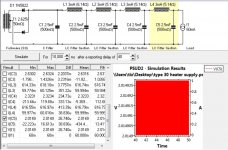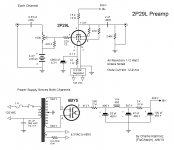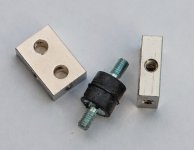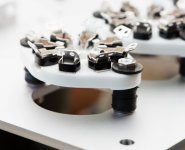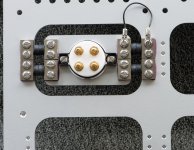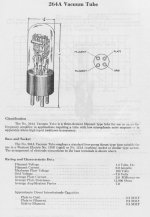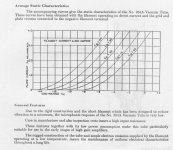Eutectic Solder should be trouble free.
Just looking again at your schematic, I see the PT is labelled 303-0-303.
Thought it was 330 per side. Is that measured with the tubes in or out?
The voltage measured drops under load conditions.
Got all the snow moved, there is a mountain of it at the end of the drive.🙂
Just looking again at your schematic, I see the PT is labelled 303-0-303.
Thought it was 330 per side. Is that measured with the tubes in or out?
The voltage measured drops under load conditions.
Got all the snow moved, there is a mountain of it at the end of the drive.🙂
The 303-0-303 was with one channel of the circuit powered. I just finished hand shoveling my driveway. I hope that’s the last big snowfall of the winter.
Type 30 as driver for triode wired EL84
After much thought about what I am building and its purpose, and a careful look at what I have available to build with, I have come up with a plan.
I have decided to keep it old school and simple, and use the type 30 tube into a triode strapped EL84. I am going to start with resistor bias and a plate resistor on the 30, and may add a CCS (the Bottlehead C4S) to the 30 later. The 30's filament is only 2 Volts at 60 mA, and I have around 25 (!) Hammond 154B chokes at hand, so I decided to try a CLCLCLCLC filament power supply. The PSUD2 sim for it is attached. Given the low voltage and especially the very low milliampere draw of the 30, and the many 154Bs that I have, I figured I would save the proven solid state stuff for another build. Any comments and opinions about the proposed CLCLCLCLC filament supply would be greatly appreciated. There really isn't very much information out there about choke based DC filament power supplies. I guess that is because the choke specifications and their associated size and cost would be prohibitive for most DHTs. Not for the 30 though. I will post my proposed power supply and circuit schematics shortly.
I will build with the 01A and 26 at some point, but it makes more sense for me to make a proper "keeper" preamp with those tubes rather than the integrated tweeter amp that I am working on. For that preamp, I will use the Coleman filament boards and filament bias, and play around with the 156C, the Bartola Gyrator, and the Camille Cascode Constant Current Source (C4S) on the plate.
After much thought about what I am building and its purpose, and a careful look at what I have available to build with, I have come up with a plan.
I have decided to keep it old school and simple, and use the type 30 tube into a triode strapped EL84. I am going to start with resistor bias and a plate resistor on the 30, and may add a CCS (the Bottlehead C4S) to the 30 later. The 30's filament is only 2 Volts at 60 mA, and I have around 25 (!) Hammond 154B chokes at hand, so I decided to try a CLCLCLCLC filament power supply. The PSUD2 sim for it is attached. Given the low voltage and especially the very low milliampere draw of the 30, and the many 154Bs that I have, I figured I would save the proven solid state stuff for another build. Any comments and opinions about the proposed CLCLCLCLC filament supply would be greatly appreciated. There really isn't very much information out there about choke based DC filament power supplies. I guess that is because the choke specifications and their associated size and cost would be prohibitive for most DHTs. Not for the 30 though. I will post my proposed power supply and circuit schematics shortly.
I will build with the 01A and 26 at some point, but it makes more sense for me to make a proper "keeper" preamp with those tubes rather than the integrated tweeter amp that I am working on. For that preamp, I will use the Coleman filament boards and filament bias, and play around with the 156C, the Bartola Gyrator, and the Camille Cascode Constant Current Source (C4S) on the plate.
Attachments
I wouldn't use a 30 tube. They're nothing special and very microphonic. Use a 26 at 7mA or for more current use a 2P29L. Both will sound better. Or a 12A would be OK. 4P1L will work but needs at least 25mA current, 30mA better.
30 sp, VT-67 is a higher filament current 30 and isn't very microphonic, but it's not the greatest sound compared with 26 or 2P29L. I wouldn't go there either, though it solves the microphonics.
30 sp, VT-67 is a higher filament current 30 and isn't very microphonic, but it's not the greatest sound compared with 26 or 2P29L. I wouldn't go there either, though it solves the microphonics.
Very good. Type 30 should be good fit here. Needs 33K load resistance min. For passive filament filter LCL or LCLCL is the idea for better isolation between supply and load as well best smoothing at the cost of less efficiency. Please look at it from engineering point of view.
Battery tubes usually suffers from ringing and micro-phony though (telling you from my own experience). But without doing this you will not be knowing, so please go ahead. You may like to design your B+ PS in such a way that it would support input/driver tube change from 30 to something else (in case you don't like 30).
For only 43mA load you need a simple PS- about 10mA ripple at El84 B+ and less than 1mA for 30 B++ that's it.
Most of the projects fail due to overboard design/plan complicacy to begin with. For the first attempt of a new idea it should be simple to implement. Wish you good luck. For a DHT amp grounding scheme and EMI isolation is the key.
Wish you good luck. Please keep us posted.
Regards
Battery tubes usually suffers from ringing and micro-phony though (telling you from my own experience). But without doing this you will not be knowing, so please go ahead. You may like to design your B+ PS in such a way that it would support input/driver tube change from 30 to something else (in case you don't like 30).
For only 43mA load you need a simple PS- about 10mA ripple at El84 B+ and less than 1mA for 30 B++ that's it.
Most of the projects fail due to overboard design/plan complicacy to begin with. For the first attempt of a new idea it should be simple to implement. Wish you good luck. For a DHT amp grounding scheme and EMI isolation is the key.
Wish you good luck. Please keep us posted.
Regards
Dear Andy, this is his first DHT project. Project will be successful if it does not hum, drive and gain are okay, no big distortion. Please let him proceed with whatever is available with him and which ever tube he fancy. Once no hum, gain is ok and drive is ok he can change the tube in the same/similar current and voltage category.
I encourage tizman to proceed and will not leave him until success.
Regards
I encourage tizman to proceed and will not leave him until success.
Regards
Hello Minhaj - you clearly have experience with these low filament current battery tubes, and you must have experienced the microphonics. While using the 30 might be simple enough in terms of design, Tizman may be facing some construction problems if the microphonics start to interfere. I use 4mm aluminium top plates, so my chassis is pretty dead, but with a thin steel chassis you can get all kinds of ringing. If it's a case of having to use sockets suspended on rubber and all the rest of it, why not just plan to use a tube that doesn't have problems with microphonics? They sound better anyway.
That's how I see it. I've been there - used 30, 31, 1G4G, 1H4G (=30) and a bunch of others. The best of that lot was the 1G4G, particularly the thin straight bottle ones. But they're very microphonic. I persevered for a while and eventually gave up. Others that used them had more problems than I did. Yes, they will be better in an amplifier than a preamp, with more signal through them, but even so.....
I do agree that a 30 with no microphonics problems is going to sound better than almost all indirectly heated tubes, so yes, the sound should be good. But there's better in DHTs. Sure - try them. Try all kinds of DHTs to get some experience of them. I did for a year or two. Ended up with cupboards full of DHTs. Still have loads if anyone wants to help take them off my hands!!!
.
That's how I see it. I've been there - used 30, 31, 1G4G, 1H4G (=30) and a bunch of others. The best of that lot was the 1G4G, particularly the thin straight bottle ones. But they're very microphonic. I persevered for a while and eventually gave up. Others that used them had more problems than I did. Yes, they will be better in an amplifier than a preamp, with more signal through them, but even so.....
I do agree that a 30 with no microphonics problems is going to sound better than almost all indirectly heated tubes, so yes, the sound should be good. But there's better in DHTs. Sure - try them. Try all kinds of DHTs to get some experience of them. I did for a year or two. Ended up with cupboards full of DHTs. Still have loads if anyone wants to help take them off my hands!!!
.
Last edited:
30 Microphonics
Take a look at the structure inside at the top of the tube. If it is the old globe type glass the support may be simply the wires coming out of the glass press at the bottom of the active part of the tube, no support at the top.
If the glass is the ST type there may be another support constructed on mica that will help stabilize the active part of the tube. I which case the microphonics would be much less.
I would go ahead & try the 30 anyway.🙂
Much snow again this AM. I'll be on the tractor in a few minutes.
Take a look at the structure inside at the top of the tube. If it is the old globe type glass the support may be simply the wires coming out of the glass press at the bottom of the active part of the tube, no support at the top.
If the glass is the ST type there may be another support constructed on mica that will help stabilize the active part of the tube. I which case the microphonics would be much less.
I would go ahead & try the 30 anyway.🙂
Much snow again this AM. I'll be on the tractor in a few minutes.
Attachments
From 30 to 01a -no need to change load resistor you need to change cathode resistor.
From 30 to 26 -need to change load and cathode resistors for 6ma current, that is it.
Andy I agree with you for all the points, but let him have the experience of micro-phony, he he its all good no harm.
Regards
From 30 to 26 -need to change load and cathode resistors for 6ma current, that is it.
Andy I agree with you for all the points, but let him have the experience of micro-phony, he he its all good no harm.
Regards
From 30 to 01a -no need to change load resistor you need to change cathode resistor.
From 30 to 26 -need to change load and cathode resistors for 6ma current, that is it.
Andy I agree with you for all the points, but let him have the experience of micro-phony, he he its all good no harm.
Regards
I certainly agree that there are less problems with the ST shape - true of 26 as well. Good point.
I took apart the breadboard and will start building the amp soon.
Since you're planning on switching to a different tube, I would strongly suggest that you try it on the breadboard first. Not everything that looks good on paper / datasheets works out as well as you have envisioned.After much thought about what I am building and its purpose, and a careful look at what I have available to build with, I have come up with a plan.
I have to say that, in my experiments, Andy's take on the sound signatures of the various DHT preamp tubes has been quite accurate. Yes, different circuits, systems, music and especially different tastes, etc, etc might result in a different final choice.
That said, I've been trying several of them anyway to hear for myself and I also plan to try the 30 and 31. But I'm definitely not going to build with a tube I haven't listened to on the breadboard first.
I do wonder, however, if the differences in sound you'll hear will correspond to Andy's impressions quite as much since you're not using any of them as a full range preamp, which is what his impressions are based upon.
Maybe I missed it, but what is the crossover point you're using? I assume that's how you're listening to them.
I have decided to keep it old school and simple . . . The 30's filament is only 2 Volts at 60 mA, and I have around 25 (!) Hammond 154B chokes at hand, so I decided to try a CLCLCLCLC filament power supply.
What you're describing is neither old school nor simple.
Old school and simple would be to use a battery to heat the 30. I once tried a 1LE3, which is a battery tube whose filament current is about the same as the 30. I heated it with a regular alkaline battery and it lasted about 24 hours. Rechargeable batteries with higher capacity are available so this is not impractical at all.
I know folks here are into complex circuits but I'm a simpleton, so your PS for a tweeter amp seems ridiculously complex to me. To each his own, of course. And if using up a bunch of chokes is a priority, it certainly accomplishes that. Hell, why not throw a couple more in for good measure. 😀
I breadboarded a 2P29L preamp a while back and it had excellent highs and the tube was not microphonic at all.
Since the 2P29L had more current draw than the 1LE3, I heated them separately with ridiculously tiny SMPS like these and they were dead quiet.
AC-DC Power Supply Module AC 1A 5W 220V to DC 3V 5V 9V 12V 15V 24V Mini ConvJju | eBay
I used a 10 ohm 1w dropping resistor to dial in the voltage and added a 6800uf 6.3v cap, although I'm not sure if it was necessary. I don't have the equipment to measure, but I compared this arrangement with a battery and I couldn't hear any difference at all.
If you search, I posted a thread on it. Here's the schematic. I'm following the same path with my current project - a higher quality SMPS for the filaments and battery grid bias, but I added a VR tube and plate chokes.
Attachments
Last edited:
Yeah, all of my experiments so far have used the ST versions and microphonics have not been a problem. I plan to try some globe versions of whatever tube I decide to build with but I'm not there yet.I certainly agree that there are less problems with the ST shape - true of 26 as well. Good point.
Good point from FlaCharlie. For the test run at least tizman can use battery for filament supply. 2x1.2 volt rechargeable unit in series and 6.6r resistor in-line will bring back supply voltage to 2 volt. If 6.6r not available 3x20r in parallel or 1x 5.6r and 1x 1r in series will do it nicely.
The 2P29L circuit is also nice. However, I get best outcome from a given triode, be it IDHT or DHT, using plate choke and Choke input PS.
I only use filament bias for small signal DHT. My next experiment will be, for IDHT signal tube, externally connecting the heater with cathode and filament bias the tube. Any of you have any experience like this? If you do please share it here.
The 2P29L circuit is also nice. However, I get best outcome from a given triode, be it IDHT or DHT, using plate choke and Choke input PS.
I only use filament bias for small signal DHT. My next experiment will be, for IDHT signal tube, externally connecting the heater with cathode and filament bias the tube. Any of you have any experience like this? If you do please share it here.
I certainly agree that there are less problems with the ST shape - true of 26 as well. Good point.
The majority of my 30s are ST. When breadboarding the 01A, it was obvious that microphonics were going to need to be dealt with. Every 01A tube I put in the breadboarded circuit would ring every time the slightest tap or vibration occurred. Almost all of my 01A are globes. I was working with the expectation of having to do a final build that was as anti-resonance and anti-vibration as possible. I have an idea for the chassis that involves a sandwiched top plate on a heavy wooden base, and the use of Green Glue.
WE264 or 864
Are built from the ground up to suppress microphonics. But I've never used one in audio. However, just after the Earth cooled I built a regen receiver with a WE264 I scored from my buddies father whose was a movie projectionist. The filament ran OK using discarded 1.5 volt, #6 Cells from the local telephone exchange. The B+ came from a 45V 'B' battery, common at the time. It ran great thru a set of 2K impedance headphones. The antenna ran out my bedroom window to the chicken coup.🙂
Are built from the ground up to suppress microphonics. But I've never used one in audio. However, just after the Earth cooled I built a regen receiver with a WE264 I scored from my buddies father whose was a movie projectionist. The filament ran OK using discarded 1.5 volt, #6 Cells from the local telephone exchange. The B+ came from a 45V 'B' battery, common at the time. It ran great thru a set of 2K impedance headphones. The antenna ran out my bedroom window to the chicken coup.🙂
Attachments
“Maybe I missed it, but what is the crossover point you're using? I assume that's how you're listening to them.”
FlaCharlie: My crossover is at 630 HZ. I do want to use up the 154Bs that I have, and this seems like a golden opportunity. The filament supply uses four per channel and has very, very low ripple, so why not?
FlaCharlie: My crossover is at 630 HZ. I do want to use up the 154Bs that I have, and this seems like a golden opportunity. The filament supply uses four per channel and has very, very low ripple, so why not?
- Home
- Amplifiers
- Tubes / Valves
- DHT driver for triode wired SE EL84, 6V6 or EL34
